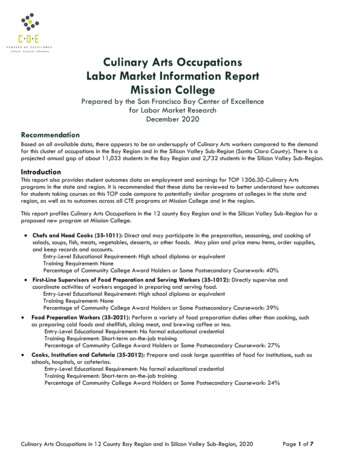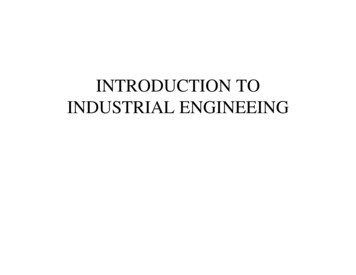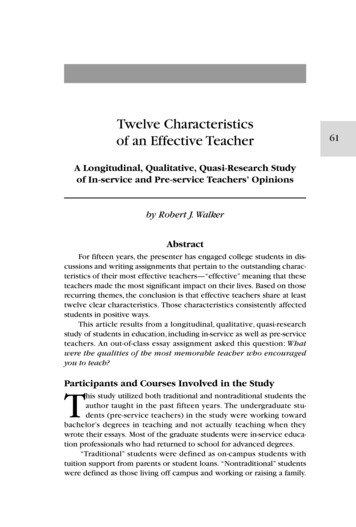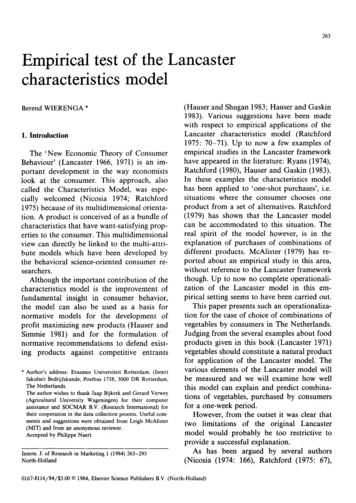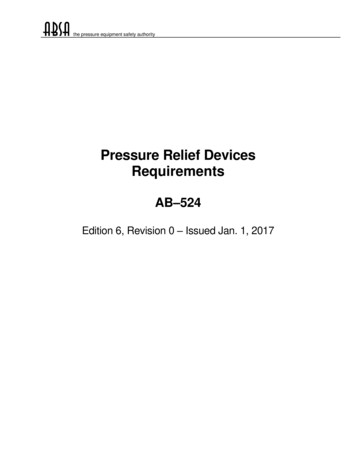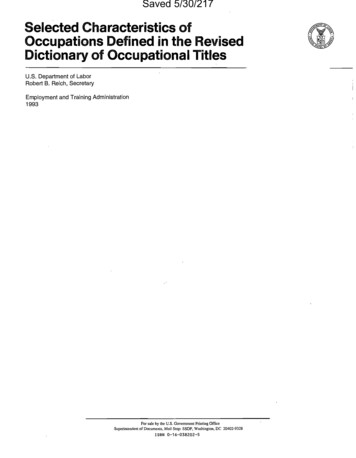
Transcription
Saved 5/30/217Selected Characteristics ofOccupations Defined in the RevisedDictionary of Occupational TitlesU.S. Department of LaborRobert B. Reich, SecretaryEmployment and Training Administration1993For sale by the U.S. Government Printing OfficeSuperimendent of Documents. Mail Stop: SSOP, Washington, DC 20402-9328ISBN 0-16-038202-5
Saved 5/30/217SCO: Selected Characteristics of Occupations in the DOTNavigate with the links below or use the Search function above.Full Document Search: Shift Ctrl FCONTENTSPageInformation for Individuals with Disabilities . ivForeword .vAcknowledgments . viSpecial Notice . viiIntroduction . . . . . . . . . . . . . viiiNavigate with the links below or use the Search function above.Part ATitles Arranged by Guide for Occupational Exploration Group, SVP, andStrength rea010203040506070809101112Artistic OccupationsScientific Occupations .Plant and Animal Occupations . . . . . .Protective Occupations . . . .Mechanical Occupations .Industrial Occupations . . . . . .Business Detail Occupations .Selling Occupations . . . . .Accommodating Occupations .Humanitarian Occupations .Leading-Influencing Occupations .Physical Performing Occupations .121314347135325349359371379411Part BIndex of Titles by Dictionary of Occupational Titles Code . 415AppendixesAppendix A: Using Selected Characteristics for . A-IAppendix B: Specific Vocational Preparation . . . B-1Appendix C: Physical Demands . C-lAppendix D: Environmental Conditions . D-lAppendix E: Occupational Code Number . . . . . E-lIdentification Key . ID-liii
Saved 5/30/217Information for Individuals with DisabilitiesUSES and all other Department of Labor Agencies, maintain a policy prohibitingdiscrimination against individuals with disabilities in all publications and materialsdistributed or made available to the public. The information in this document willbe made available to sensory impaired individuals upon request. Information onspecific job or worker traits may be obtained by voice phone directly from thenearest Occupational Analysis Field Center listed below:Massachusetts Occupational Analysis Field CenterResearch and Statistics SectionCharles Hurley Building, Second FloorGovernment CenterBoston, Massachusetts 02114(617) 727-6718Michigan Occupational Analysis Field CenterMichigan Employment Security Commission7310 Woodard Avenue, Room 425Detroit, Michigan 48202(313) 876-5140 or 876-5198Missouri Occupational Analysis Field CenterDivision of Employment SecurityNorth Carolina Occupational Analysis Field CenterEmployment Security Commission of NorthCarolinaPost Office Box 27625Raleigh, NC 27611(919) 733-7917505 Washington AvenueSt. Louis, Missouri 6310 1(314) 340--4780Utah Occupational Analysis Field CenterDepartment of Employment Security140 East Third SouthSalt Lake City, Utah 84111(801) 536-7690The TDD Message Referral phone number is 1-800-326-2577.Additional comments or questions regarding this material may be directed to:Ms. Donna Dye,Manpower Development SpecialistUnited States Employment Service200 Constitution Ave. NWWashington, DC 20210(202)-219-7161.iv
Saved 5/30/217ForewordThe Selected Characteristics of Occupations Defined in the Revised Dictionary ofOccupational Titles (SCO) is published in response to the special needs of publicand private organizations for more detailed occupational data than that containedin the Revised Fourth Edition Dictionary of Occupational Titles. This documentprovides, in a single volume, a wide range of occupational information with a variety of applications ranging from job placement to occupational research, careerguidance, labor market information, curricula development and long range jobplanning. This information may prove very timely and helpful to employers andorganizations adjusting to regulations under the Americans with Disabilities Act.Data contained in this book supersede the information presented in the three previous editions including Selected Characteristics of Occupations (1966), SelectedCharacteristics of Occupations by Worker Traits and Physical Strengths (1968)and Selected Characteristics of Occupations Defined in the Dictionary of Occupational Titles (1981).The information documented in the SCO was developed using the methodologyand benchmarks used in the USES Occupational Analysis Program for gatheringand recording information about jobs listed in the Dictionary. In this document,adjunct data on specific vocational training time, physical demands, and environmental conditions are listed for each occupation defined in the Dictionary andgrouped according to interest factors identified in the Guide for Occupational Exploration. Explanations of the rating structures for Physical Demands and Environmental Conditions are found in Appendixes C and D.Among other uses, the data can be helpful in determining the potential for an impaired or disabled individual to transfer from one occupation to another. In addition, it can also help job interviewers or counselors evaluate an individual's skillslearned on the job, in the military, or through non-job experience or interests, andhelp determine new careers for displaced workers as well as benefits eligibility forimpaired workers.Other major Occupational Analysis products which are based on information in thesame data base include the Revised Fourth Edition Dictionary of Occupational Titles, the Revised Handbook for Analyzing Jobs, and the Revised Guide for Occupational Exploration. All of these publications are available from the' U.S. Government Printing Office.Robert A. SchaerflDirectorU.S. Employment Servicev
Saved 5/30/217AcknowledgementsThe revised Selected Characteristics of Occupations (SCO) was produced under anInteragency agreement with the Social Security Administration by the U.S. Employment Service under the direction of Robert A. Schaerfl, director. The Occupational Analysis Program is directed by Susan C. Schlickeisen, chief, Division ofPlanning and Operations. Coordination and technical supervision for the development of the revised SCO was directed by Russ Kile, Personnel Research Psychologist, of the Operations unit. Acknowledgement is also gratefully given to JohnHawk, Personnel Research Psychologist, and Kathleen Wiersema for the contribution of additional technical planning and support.This publication was produced and developed through the efforts of the followingOccupational Analysis Field Centers, operated through the State Employment Services; Boston, Massachusetts, Paul Clearly, Supervisor; Detroit, Michigan, TomKearney, Supervisor; St. Louis, Missouri, Doris Phelan, Supervisor; Raleigh, NorthCarolina, Stan Rose, Supervisor; and Salt Lake City, Utah, Barbara Smith, Supervisor.Space does not permit a listing of their names, but grateful acknowledgement isalso given to those associations, business firms, labor organizations, and other Federal Agencies, and Individuals whose assistance and cooperation contributed significantly to the developIPent of this publication.vi
Saved 5/30/217Special NoticeData contained in the Selected Characteristics of Occupations Defined in the Revised DictionaJY of Occupational Titles (SCO) reflects certain elements of workas they have generally been been found to occur in jobs, but these ratings maynot coincide in every respect with the content of jobs as performed in particularestablishments or at certain localities. Data presented in this revised Selected Characteristics were collected and organized according to job analysis methodology developed by the US Employment Service through affiliated State OccupationalAnalysis Field Centers. Users who need more specific job requirements shouldsupplement this data with local information detailing jobs within their community.In preparing this document, no data elements regarding wages or hours of workhave been collected. Therefore, data contained in this publication should not beconsidered a judicial or legislative standard for wages, hours, or other contractualor bargaining elements.Material contained in this publication is in the public domain and may be reproduced fully or partially, without the permission of the Federal Government. Electronic distribution of this information is under a grant agreement with the NorthCarolina Occupational Analysis Field Center. Source credit is requested but not required.Comments or inquiries regarding data elements included in the revised SCO areinvited and should be addressed to:Mr. Stanley Rose, SupervisorNorth Carolina Occupational Analysis Field CenterEmployment Security Commission of North CarolinaPost Office Box 27625Raleigh, North Carolina 27611FAX (919) 733-0981Telephone (919) 73 3-7917vii
Saved 5/30/217IntroductionDescription and Arrangement of Databy the Specific Vocational Preparation (SVP) rating; thethird is based on the Strength Level (SL); the final arrangement is by DOT code. All codes within each sortare in ascending order (from lowest to highest).The sea provides supplemental information on all occupations printed in the revised fourth edition Dictionmy.Each occupation is listed in both Part A: "Titles Arranged By Guide for Occupational Exploration Group,SVP, and Strength Level" and Part B: "Index of Titlesby Dictionmy of Occupational Titles Code."Because sorting by these Worker Characteristic components negates or loses the numerical and alphabeticalsorting features of the Dictionmy, the sea provides acrosswalk between DOT and GOE codes. Part B lists alloccupations in the Dictionmy, in ascending order byDOT code with a corresponding reference to their respective GOE code. This feature enables the use toquickly determine a DOT code's location with the GOEclassification structure contained in Part A.Part A lists occupations that have been sorted by severalWorker Characteristics components. Worker Characteristics are job analysis components which reflect worker attributes that contribute to successful for job performance.Each Dictionary occupation has been rated for these various Worker Characteristic components to provide information for determining a worker's suitability for a particular job. Additional information about Worker Characteristics and the techniques of job analysis as used byoccupational analysts affiliated with the U.S. Employment Service may be found in the Revised Handbook forAnalyzing Jobs (HAJ), 1991.Users who do not have access to the DOT code of anoccupation, are directed to the "Alphabetical Index ofOccupational Titles" in the Dictionmy itself. Both theDictionalY and Part of the sea contain occupations arranged by DOT code. In addition, each entry in Part Bas well as the definition trailer in the Dictionmy includethe GOE code and Strength Level of the correspondingoccupation.The first level of organization is according to the Guidefor Occupational Exploration (GOE) code; the second isviii
Saved 5/30/2173. Strength Level and Other Physical DemandsPart A: Titles Arranged By Guide for OccupationalExploration Group, SVP, and Strength LevelAfter SVP, occupations are sorted by Strength Level.The five Strength Levels (Sedentary, Light, Medium,Heavy, and Very Heavy) provide a means to rank occupations by the amount of force or physical effort exertedby workers. Appendix C: "Physical Demands" containsadditional information about Strength Level and nineteenother Physical Demand components.Part A of the SeQ contains ratings or values for someof the components used in the Occupational AnalysisProgram of the U.S. Employment Service. (Additionalinformation about these and other components of occupational analysis used in USES may be found in Appendix A in this publi cation as well as the HAl.) Thesecomponents are also briefly explained in the followingparagraphs. Occupations are arranged according to theratings of some of these components (GOE, SVP, SL,and DOT Code). The values of other component ratings(Physical Demands, except Strength Level, and Environmental Conditions; DOT Title; and Industry Designation)are referenced even through they were not used in thesorting process.4. Environmental ConditionsThe Environmental Condition components provide ameans to describe the immediate surroundings in whichworkers must perform a job. Appendix D: "Environmental Conditions" contains additional informationabout the Environmental Condition components. None ofthese components were used to rank occupations in PartA.1. Guide for Occupational ExplorationThe first level of arrangement in Part A is according tothe GOE codes. (Appendix A: "Using Selected Characteristics for Occupational Exploration" contains additional information about the GOE structure.)5. DOT CodeThe final sort of occupations within a GOE Subgroup isby nine-digit DOT code. The DOT code structure provides unique identification as well as a means to clusteroccupations which require workers to perform similartasks. Appendix E: "Occupational Code Number" contains additional information about the DOT code structure.The GOE structure contains 66 Work Groups and 348subgroups. Work Groups, represented by the first fourdigits of the GOE code, contain occupations which areof the same general type of work and require the sameadaptabilities and capabilities of the worker. The WorkGroup code, title, and definition appear at the top of thelist of occupations within the Work Group.6. DOT TitleSubgroups, identified by the last two digits of the GOEcode, represent specific clusters of occupations withinWork Groups. Subgroup codes and titles precede the listof occupations within the Subgroup. Subgroups range insize from one to 430 occupations.The DOT title is the title by which the occupation isknown in the majority of establishments in which analysts found the job.7. Industry DesignationThe industry designation is the information that appearsin parentheses after the DOT title. Because some occupations are found in more than one industry, some occupations may have up to four industry designations. TheDOT industry designation provides one or more additional items of information about an occupation. In thefollowing list, the industry designations are examples ofadditional information. Those listed are not the only oneswhich provide this type of information.2. Specific Vocational PreparationWithin GOE Subgroups, occupations are further sortedby SVP. The SVP structure provides a means to clusteroccupations which require a similar amount of time forworkers to learn the skills, know ledges, and abilities required to achieve acceptable performance in a specificoccupation. Appendix B: "Specific Vocational Preparation" contains additional information about SVP.ix
Saved 5/30/217 location of the occupation (hotel & rest.; machineshop)ment" to prevent confusion during (1) collection andanalysis of source material and (2) compilation of thatsource material into DictionalY definitions types of duties associated with the occupation(education; forgoing) products manufactured (optical goods; textile)An Element is the smallest step into which it ispractical to subdivide any work activity withoutanalyzing separate motions, movements, an mental processes. processes used (electroplating; petrol. refm.) raw materials used (nofer. metal; stonework)A Task is one or more elements. It is a distinctactivity in the logical and necessary steps or workperformed by an individual. Any human effort,physical or mental, exerted to accomplish a specific purpose is a task.Part B: Index of Titles by Dictionary of OccupationalTitles CodePart B of the SeD contains pccupations arranged numerically by 'nine-digit DOT code. In addition, the listingfor each occupation includes the COE code, StrengthLevel, DOT title, an industry designation. Brief explanations of each of these components appeared in the previous section.A Position is a collection of tasks that constitutethe total work assignment of a single worker.(There is one position for every worker in thecountry.)A Job is a group of positions, within an establishment, which are identical with respect to theirmajor or significant tasks and are sufficientlyalike to justify inclusion within a single piece ofsource material. (Element, task, and job are relative concepts. An activity that is an element inone job may be a task or even entire job in otherposition-worker settings.)Identification KeyThe Identification Key, on the last two pages of theSeD, is provided to aid users with the identification ofthe numbers, letters, and headings for the colunms forthe DOT code, Specific vocational Preparation, PhysicalDemands, and Environmental Conditions in the tables ofPart A and B. The key may be photocopied or removedand used as a desk reference.An Occupation is a group of jobs, found at morethan one establishment, in which a common setof tasks are performed or are related in terms ofsimilar objectives, methodologies, materials,products, worker actions, or worker characteristics.Collection and Aggregation of DataThe Occupational Analysis Program, within the UnitedStates Department of Labor, does not establish or dictatetitles, descriptions or characteristics of occupations. Analysts do not participate in individual negotiations between individual establishments and employees regardingtasks or positions.An Establishment is a public private employingunit that produces, provides, and/or sells goods orservices at a single, physical location. It mayrange in size from a single, self-employed workerto thousands of workers. Within an establishment, there may be one or many persons employed inthe same job.Analysts rate jobs, not workers. Based upon face-to-faceobservation/interviews with incumbents and/or their supervisors, analysts rate what jobs require of workers andnot what individuals workers bring to specific jobs.Therefore, there are instances when the individual qualifications of a worker or the specific hiring requirementsof an establishment for a specific position do not matchthe characteristics of a broadly defined occupation.After reading the definitions from "element" through"occupation," users should understand that analystscompile information from many jobs into an occupationdefinition. the occupation information available in theDictionalY, either its printed or electronic versions andsupport documents, represents data compiled from manyjobs. The information does not represent the tasks of asingle worker.In some situations people use the words element, task,position, job and/or occupation as synonyms. The UnitedStates Employment Service (USES) developed and usesthe following definitions as well as one for "establish-For those components with ranges such as SVP, PhysicalDemands, and Environmental Conditions, analysts deter-x
Saved 5/30/217mine that a component rating falls somewhere within therange. They never, however, place the rating at a specificpoint. At a later time and based on many pieces ofsource material, when analysts select a rating for an occupational component, they determine that the typicalrating for that occupation is somewhere within thatrange. Further, they never imply or determine that alljobs within a specific occupation across the UnitedStates have a rating at the same point within the continuum of the range.tio/wry. Unique hiring requirements are not sufficient to(1) cause the position to have a different Specific Vocational Preparation (SVP) Code from the occupation, (2)place the position within another occupation, or (3)change the rating of the composite occupation withinwhich the position falls.In addition, individual hiring requirements of tasks for aspecific job in an establishment may exceed (or be lessthan) the equivalent component for the composite occupation as defined in the Dictionary and SeD. Isolated instances of such occurrences will not warrant changes tothe composite occupational definition contained in thesedocuments. Only observation by occupational analysts ofchanges in requirements in most of the jobs used assource material may result in a revision of the ratings foran occupation.Composite Occupational information Verses SpecificWorker-Employer InformationPeople occasionally see significant differences betweenthe work performed in the plant or establishment and thecharacteristics ascribed to the same occupation in theDictionmy or SeD. There are instances when the individual qualifications of a worker or the specific hiringrequirements of an establishment for a specific positiondo not exactly mater the characteristics described for abroadly defined occupation, such as those contained inthe SeD.The USES emphasizes these limitations because occupational analysts are unabl/e to study each job in every establishment in the United States. In addition, analystsalso write definitions in such broad terms that everystatement (or factor) may not match verbatim every position or job included within the occupation/throughout theUnited States. Finally, employers may qave hiring requirements for a specific position, which mayor maynot fall within the typical range for all similar positionsidentified with that occupation.Based. upon fact-to-face observation/interviews with incumbents and/or their supervisors, USES occupationalanalysts rate jobs, not workers, that is,they rate whatjobs generally require of workers and not what individual workers are expected to perform on specific jobs. Anindividual employer may demand specific position requirements (tasks) from an incumbent, such as the abilityto speak, read, and write a second language, which arenot included within the occupation as defined in the Dic-USES realizes that this is a highly technical field ofstudy. Additional comments or questions regarding SeDratings may be directed to staff in the OccupationalAnalysis Field Center nearest you. (See the addressunder special notice.)xi
Saved 5/30/217PART ATitles Arranged By Guide For Occupational Exploration Group, SVP, and Strength Level05.09 Materials ControiOccupations in this group are concerned with activities related to receiving, storing, and/or shipping materials; estimating and ordering materialsand supplies; coordinating flow of materials through establishments; and maintaining inventory and related stocle records. Skills and abilitiesrequired include: Applying basic math skills and visual abilities to maintain records, conduct inventories, and estimate quantities; verifying completenes of articles shipped or received; using hands and fingers to pack, store, or sort articles; and lifting and handling bulky materials andproducts.svDOT CodeDOT TitI.IDOT Industry DesignatIon(s)Physical DemandsCBSKCCRHF. Environmental ConditionsFTHTNFDACFWCHHNVAMEHRETOllDlnowcnie a 'e S A A P c V Ve o.L NNNNNNFFONNNNONNNONNNNN3NNNNNNNNNL NNNNNNOFONNONFNNNNNNNNN3NNNNNNNNNL NNNNNNFFONNNNFNFNNNNNNN4NNNNNNNNFL NM NNF NNNF F NNNNNNNNNMNNONONFFNNNNNFNNNNNNNNN4NNNNNNNNNH NNONNNCCONNNNOOOOONNNNN3NNNNNNNNNH NNNNNNFFNNNNNNNNNNNNNNN4NNNNNNNNNL NNONNNFFFNNONFNNOONNNNN2NNNNNNNNNL NNNNNNFFFNNNNFNNNNNNNNN2NNNNNNNNNL NNONNNFFFNNONFNNNNNNNNN4NNNNNNNNNL NNNNNNOONNFFNONONNNNNNN2NNNNNNNNNL NNNNNNFFONNNNFNNONNNNNN2NNNNNNNNNL NNNNNNFFFNNNNFNNNONNNNN2NNNNNNNNNL NNNNNNFFONNNNONNNNNNNNN2NNNNNNNNNL NNNNNNFFFNNNNFNNONNNNNN3NNNNNNNNNL NNNNNNFFFNNNNFNNONNNNNN3NNNNNNNNNL NNNNNNFFFNFFNFOOFOONNNN3NNNNNNNNNL NNFH OOONNNFFFNFFNFNNNNNNNNN3NNNNNNNNNH NNNNNNFFFNNNOFNNONNNNN04NNNNNNNNNL NNONONFFFNNNNFNNNNNNNNN3NNNNNNNNNP0 U 0i CPS E a x Cl05.09.01 Shipping, Receiving, and Stocll Checiling221.587-018222.387 -07 4ODD-PIECE CHECKER(knilting)SHIPPING-AND-RECEIVING WEIGHER(clerical)919.687-010CHECKER(motor (mns.)920.687-118LINEN-SUPPLY LOAD-BillLDER(laundry & reI.)222.387 -03 0LINEN-ROOM ATTENDANT(hotel & rest.; medicnl ser.)222.684-010MEAT CLERIC(relfiil trade)369.687-026MARICER(laundry & reI.)922.687-058922.687 -066LABORER, STORES(any industry)LAST PUTTER-AWAY(boot & shoe; rubber222.487-010good )CHECKER, BAKERY PRODUCTS(bakery produclS)504.686-018HARDENER HELPER(clock & walch)074.382-010PHARMACY TECHNICIAN(medlenl scr.)209.387-026LIBRARY CLERIC, TALKING BOOKS221.587-030TALLIER222.367-030FLOOR-SPACE ALLOCATOR(libmry)(clerical)(tobncco; wholesale lr.)222.387-022GUN-REPAIR CLERK(ortlmmce)222.487-014ORDER FILLER(rel,il trade; wholesale tr.)222.587-026LABORATORY CLERK(clerical)222.587-030MAlLER(prinl. & pub.)222.587-032MAILER APPRENTICE(prinl. & pub.)249.363-010BOOICMOBILE DRIVER(Iibmry)339.687-010SUPPL Y CLERK(personnI scr.)221.487-010LUMBER SCALER(woodworking)222.485-010MILK-RECEIVER, TANK TRUCK(d,iry products)222.587-054TRANSFORMER-STOCK CLERK(utilities)241.367-034TIRE ADmSTER(relail trude)922.667-010YARD WORKER, USED BUILDING MATERIALS(relnil trade)222.367-042PARTS CLERK(clerical)222.585-010MILK RECEIVER(dDiry products)222.367-014CUT-FILE CLERK4(priOI. & pub.)95
Saved 5/30/217PART AMaterials Control05.09svPhysicnl DemundsEnvironmental ConditionsDOT TillemOT Industry Deslgnution(s)PCBSKCCRHFllntnoweni222.567-010GRAIN ELEVAlUR CLERK(beverage; grain-feed mills)4L NNNNNNFFFNFFNFFNFNN222.567-014SHIP RUNNER(water trans.)4L NNFNNNFFNNFFNFNNNNNNNNN2NNNNNNNNN222.687-026SAMPLE DISPLAY PREPARER(knitting)4L NG CHECKER(clerical)4L NNONNNFFFNNNNFNNFONNNNN3NNNNNNNNN229.367-014PARTS LISTER(electron. camp.)4L -LAMP KEEPER(mine & quarry)4L ORY N922.684-010LOCKER-PLANT ATTENDANT(retail trade; wholesale STOCK CLERK(clerical)4H NNOOONFFONNNNFNNNONNNNN2NNNNNNNNN299.367-014STOCK CLERK(retail trade)4H NNONONFFONOONONNNNNNNNN3NNNNNNNNNDOT CodeFTHTNFDACFeaeSAAPcVVWCHHNVAMEHRETOeoouoi CPSEnxCtNNNN2NNNNNNNNN222.387-042PROPERTY CUSTODIAN(molion picture)L EEPERL NNNNNNFFFNNNNFNNNNNNNNN2NNNNNNNNN(water trans.)222.387-066SAMPLE CLERK(plastic prod.)L ORDER-AND-STOCK CLERK(clerical)L NNFFNNFFFNFFNFNOONNNNNN2NNNNNNNNN222.367 -062TOOL-CRIB NNN222.387-050SHIPPING AND RECEIVING 48.367 -0 18CARGO AGENT(air trans.)M NNNNNNF F FNFFNFNONNNNNNN3NNNNNNNNN969.367-010CUSTODIAN, ATHLETIC EQUIPMENT(amuse. & PRODUCTION TECHNICIAN, SEMICONDUCTOR PROCESSINGEQUIPMENT(electron. 8STAMP CLASSIFIER(reillil DISTRIBUTION SUPERVISOR(pipe lines; wholesnle NEN-ROOM SUPERVISOR(laundry & reI.)L NG-AND-RECEIVING SUPERVISOR(clerical)L NNOONNFFFNFFNFOOFNNNNNN2NNNNNNNNN222.137-034STOCK SUPERVISOR(clerical)L RIB SUPERVISOR(clerical)L CONTROL COORDINATOR(non fer. mem)L EPARTMENT SUPERVISOR(grain-reed mills)L ORAGE CLERK(retail u-ade)L CHER(construction)L NNNNNNFFONFFNFNNNNNNNNN4NNNNNNNNN922.137-030YARD. SUPERVISOR(forestry )L NNNNNNFFFNFFNFNFNONFNNN4NNNNNNNNN952.367-010LOAD CHECKER(utilities)L ISOR, FINISHING DEPARTMENT(photo finishing)L NNNNNNFFFNFFNFNOOFNNNNN3NNNNNNNNN222.137-0 I 0FILM-VAULT SUPERVISOR(molion picture)L USE SUPERVISOR(any industry)L -COMMISSARY AGENT(air Irons.)MNNFFFNFFONFFNFONNNNNNNN3NNNNNNNNN05.09.02 Estimating, Scheduling, and Record Keeping221.482-018TICKET WORKER(lobncco)L NNOOONF F e)L NNNN
Guide for Occupational Exploration The first level of arrangement in Part A is according to the GOE codes. (Appendix A: "Using Selected Charac teristics for Occupational Exploration" contains addi tional information about the GOE structure.) The
